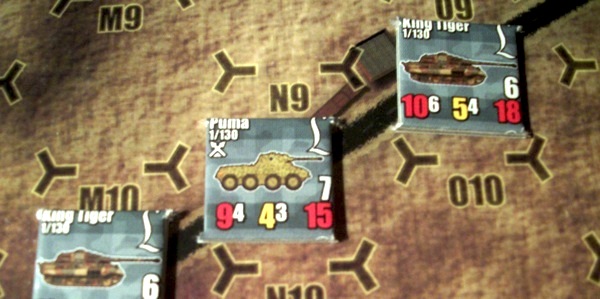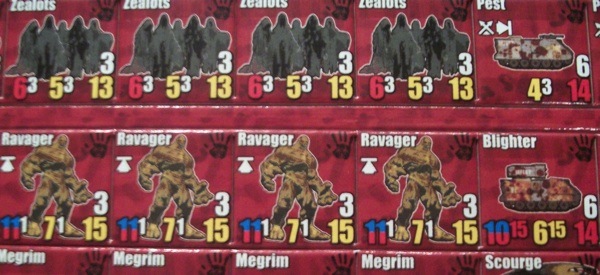Nuklear Winter ’68 – Boardgame Review
 Nuklear Winter ’68. Boardgame. Lock ‘n Load Publishing. Designed by Petre Tutunea. $49.95
Nuklear Winter ’68. Boardgame. Lock ‘n Load Publishing. Designed by Petre Tutunea. $49.95
Passed Inspection: High-quality components; great design for gaming a variety of weapons systems; high concept background
Failed Basic: Black type on brown paper makes rulesbook difficult to read; unit combat values seem too even given the generational differences between opposing forces
In the chaos following Hitler’s assassination in 1944, Heinrich Himmler and his SS seized control of Germany. Without Hitler’s interference, the German army began turning the tide, stopping the Russians cold and re-deploying enough troops to stalemate the Allied invasion of Western Europe. In an arms race with the US, the Germans discovered the atomic bomb first and used V2 rockets with atomic warheads to destroy Paris and London. The US retaliated by dropping massive numbers of atomic bombs all across Germany, turning the heart of Europe into a wasteland and triggering a nuclear winter that lasted for nearly a quarter of a century.
{default}This is the world of Nuklear Winter ’68, the latest offering from Lock ‘n Load Publishing. The Berlin Wall has become the German Wall, a massive structure that encircles what was once Germany. Reconnaissance flights indicate that there is yet life in Germany, twisted mutations and once-human scavengers. As the nuclear winter begins to end, recon also shows that the Nazi threat did not die; before the A-bombs dropped, Himmler led his Master Race into underground bunkers where they have been hiding and breeding, preparing for a new assault.
I have to begin my review with a complaint. Whoever it was at Lock ‘n Load that thought printing black text on brown pages would look so cool—bludgeon that person with office equipment. The black-on-brown printing (with brown-on-brown charts and examples of play) makes these rules and charts nearly impossible—or at least very eye-straining—to read.
Once you manage to actually read the rulesbook, however, you’ll find a solid wargame under all the sepia tones. The Nazis are literally re-surfacing, bringing their dive bombers and Panther tanks to conquer Europe again. Facing them are NATO troops (with occasional Soviet help) with modern battle tanks, helicopters, and artillery. Both sides have to deal with the Black Hand, a mysterious and powerful group of mutants who would like to be left alone in their homeland.
To game this three-way conflict—most scenarios are two-player, with NATO fighting Nazis or either of them battling the mutants, though a three-player campaign is included—you get the aforementioned blindness-instilling rulesbook, 3d6, two great-looking full-color countersheets (352 counters), and a heavy 20×30 inch mounted map of the wasteland that Germany has become (focused around Welwesburg Castle, Himmler’s historic headquarters).

NATO, Nazis and mutants—what more could you ask?
Choose one of the scenarios—even the shortest will take about two or three hours to play, while the campaign game can take a few days to finish—and set your units up. The game uses the chit-pull system that I am a big fan of for game turns. Units belong to specific formations—1st Ranger, for example, or 2/501 SS—and each formation has its own activation chit. (The Nazis get two chits per unit since they are fanatical and disciplined, while the Black Hand have no formations and get two activation chits each scenario, each of which activates their whole force.) Put the chits for each formation in the scenario in a small cup, along with an Event Chit (sometimes two Event Chits), and begin each turn by randomly drawing a chit. The number of formations in play determines the number of chits drawn per turn. The seemingly complex but actually easy-to-play formula is: the number of formation chits + number of event chits – number of players. So in one of the introductory Nazi vs. NATO two-player scenarios, with one formation per side (Nazis get two activation chits, remember) and one Event chit, then only two chits are drawn each turn (2 Nazi chits + 1 NATO chit + 1 Event chit = 4 chits; 4 chits – 2 players = two chits drawn each turn).
Drawing an Event chit means you roll 2d6 and consult the brown text on brown background Events Chart. It usually conjures up more mutants, though results also include a discovered ammo bunker, automatic rally of one of the drawing player’s units, and so on. Drawing a formation chit means the units of that formation can act by moving and / or attacking.
Movement is a basic movement-point-based-on-terrain system, with different costs for infantry and vehicles. Stacking is two combat units per hex at the end of movement; any number of units may move through a hex during movement. Units with their movement allowance in white may fire on the move; they may move up to half their movement allowance and attack with a -2 penalty, or attack with a -2 penalty and then move up to half their movement allowance. Units which don’t fire on the move must choose to either move or attack.
Attacking is done by rolling 2d6, adding in any modifiers (such as -2 for firing on the move or +1 for stacked units combining fire), then compare to the defending unit’s armor value (modified by terrain). You want to roll higher than the armor, and each point the attacker rolls that is higher than the defender’s result counts as one hit. One hit causes a unit to be Shaken, two hits causes it to be reduced (flipped to its lesser value side), three hits is an elimination. If a unit does not move or fire it is assumed to be in overwatch and can use Opportunity Fire during the opponent’s activation and movement.

The focus of the game design is on how different units interact with each other, so knowing the color-coded numbers all over your counters is important! Most units have two combat factors, and each factor has a small range number beside it. Red numbers are for Armor Piercing, yellow numbers are High Explosive, and blue numbers are Anti-Aircraft. So a tank will have a red 10 on it because it is designed to kill vehicles (the 10 is added to the 2d6 attack roll against hard vehicle targets), while elite infantry has a yellow (HE / anti-personnel) 5 with which to kill other light armored troops. Ranges in white mean the unit can fire at twice that range but with a -2 attack modifier. Movement factors in white indicate fire-on-the move capability. Brown stripes mean the troops carry chocolate bars—okay, just kidding, the game doesn’t go that far.
Air units are limited but powerful. The Nazis have a Stuka dive bomber, NATO enjoys helicopters and ground support attack planes, and the Black Hand have mini-dragons called Scourges. Great aircraft movement and attack rules simulate dive bombings and hovering. Add in off-map artillery missions (mostly for NATO) with ammunition types from smoke to nukes, minefields, and basic command radius rules and you’re enjoying a solid wargame with a great background.
On the whole, the Nazis are weaker but only by a point or two of attack and armor factors per unit, and a few of their units are actually more powerful than NATO squads or tanks. The Nazi advantage is in their discipline and organization; they get two activation chits per formation, making it more likely that they will act. NATO, beset both by a cumbersome multi-national command and more modern communications equipment that is more susceptible to breakdown in the radiological wastes, have only one activation chit per formation. The Black Hand mutants have no formations but get two activation chits; when drawn, every mutant on the map gets a go, and their units run about equal with the best NATO and Nazi units.
Which is a problem, it seems to me. How can a bunch of mutant scavengers, using 1940s werhmacht vehicles and the occasional NATO wreck, produce tanks that are actually better than NATO main battle tanks? How can a bunch of fifty-something SS guys, with their twenty-something sons, come out of bunkers after a quarter century and be a match for Army Rangers and Spetsnaz troops?
I love the background. I get that the Nazis and Black Hand enjoy esprit de corps, hence their twice-as-likely activation. I like the freaky mutants such as the ogre-like ravagers. I understand that a nuclear winter mixed with a protracted cold war (no pun intended) would stagnate technology and military innovation. But throw a 1945-era tank against one designed and built in 1967 and I’m expecting a bigger difference than a one-point variation in armor—and that point is in favor of the older tank!

The Black Hand is overpowering when you consider that 7 out of 12 events give them more units (a ravager shows up, or more infantry appear to launch suicide attacks against enemy units, etc.). The unit values just seem too "par." The best design, in my opinion, would have been for a small but powerful NATO force, a few infantry and tanks with some limited airpower and off-map artillery to stomp holes in their opponents, facing off against the larger and more fanatic Nazi army, with the Black Hand being a near-endless collection of "weenie" units, weak infantry and vehicles that keep coming back, supported by a few powerful mutant beings.
The editing and graphics in the rulesbook could have been a little better. Beyond the black text on brown paper problem, the images used to illustrate the scenarios are sepia-toned WWII and Vietnam photos. Sepia photos. On brown pages. Just run the rulesbook through an acid wash to finish the job! Editing is okay, but I feel the sequence of play and general rules should have come before the unit-by-unit specifics; as it is, a few important rules (like opportunity fire) can be missed the first few times you play the game.
All of that aside, this is still a great game. The alternative history background is high concept, the rules for movement and combat are straightforward and easy to game, and the wide variety of weapons systems and vehicles are handled without bogging down play. I always like the chit-draw system for game turns and initiative. If you want to play a hard-core 1940 Nazi vs. 1960 NATO military simulation just ignore the scenarios with mutants and either do away with the events or change the events chart to your liking—but I recommend keeping the quasi-science fiction setting.
Nuklear Winter ’68 is a well-done game, with high value components at a great price for today’s gaming. I don’t agree with the combat and armor values on the units, but I had a heckuva good time smashing through some Spetsnaz troops with a single mutant ravager, so as gaming goes it still works. A wonderful concept given form as a wonderful game. If I could only read the rules …
Overall Rating: 86%
Solitaire Rating: 4 of 5 (tactics tend to be straight-on, especially when playing the mutant Black Hand)
About the Author
Sean Stevenson has been gaming since the SPI days of the late 70s. His gaming collection now includes over 1700 games. He has just opened a gaming shop in Pittsburgh, Pennsylvania.


0 Comments
Trackbacks/Pingbacks